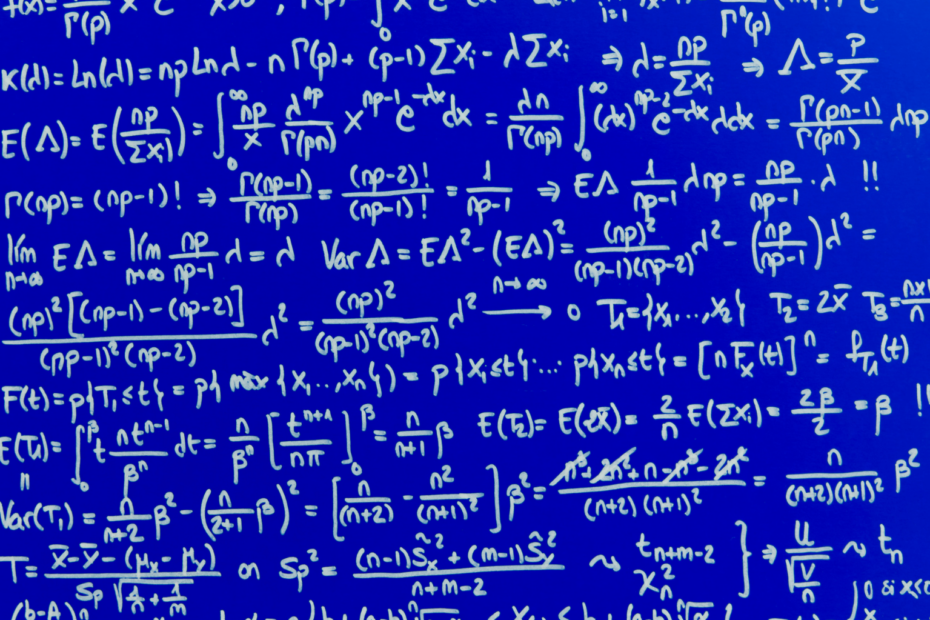The expected value describes which result can be expected in a random experiment if it is repeated very often. The term comes from probability theory, the so-called stochastics. In the case of a dice roll, for example, the expected value provides information about the value that can be expected in the long term if the dice are rolled very often in succession.
Note: In general, the expected value and the arithmetic mean are two different concepts, which in most cases will also differ for the same random experiment. Only if a random experiment is repeated infinitely often, the expected value and the arithmetic mean have the same value.
How is it calculated for discrete random variables?
A random experiment with a discrete random variable is characterized by the fact that there is only a finite set of outcomes. In the case of a dice roll, this means that the result must be one of the six numbers between 1 and 6. The numbers of the dice have the following probabilities of occurrence:
| x | 1 | 2 | 3 | 4 | 5 | 6 |
| P(X = x) | 1/6 | 1/6 | 1/6 | 1/6 | 1/6 | 1/6 |
For a discrete random variable X, which takes the values x1, x2, …, xn with the probabilities P(X = xi ), one calculates the expected value E(X) as follows:
\(\) \[E(X) = x_1 \cdot P(X = x_1) + x_2 \cdot P(X = x_2) + … + x_n * P(X = x_n)\]
In words: The expected value is the sum of all values of the random variables multiplied by their probabilities.
For our example, this means:
\(\) \[E(X) = 1 \cdot \frac{1}{6} + 2 \cdot \frac{1}{6} + 3 \cdot \frac{1}{6} + 4 \cdot \frac{1}{6} + 5 \cdot \frac{1}{6} + 6 \cdot \frac{1}{6} = \frac{21}{6} = 3,5 \]
This means that in the long run, you can expect a value of 3.5 when rolling a single dice.
How is it calculated for continuous random variables?
If the random variable in the experiment can take any value within a certain interval, it is called a continuous random variable. Continuous random variables are, for example, body sizes, the average temperature in a refrigerator, or the speed of a car at a speed camera. Continuous random variables occur above all when the value comes about through a measurement process and the process is influenced by disturbance variables.
If we want to calculate the expected value for a continuous random variable, we cannot do this by summing up all possible values of the random variable multiplied by the corresponding probability, since there is theoretically an infinite number of values that the variable can assume. Therefore, the probability distribution of a random variable is described by the density function and its integration with the distribution function. We already know this from the normal distribution.
What is an example of the expected value?
The refrigerator temperature varies between 0 and 4 degrees Celsius when the door is opened or because electricity is to be saved. Many modern refrigerators purposefully allow the interior to warm up a bit before starting to cool again, in order to operate as efficiently as possible and save electricity. These variations can be described by this density function:
\(\) \[f (x) = \left\{
\begin{array}{ll}
-0,125x + 0,5 & 0 \leq x \leq 4 \\
0 & \, \textrm{sonst} \\
\end{array}
\right. \]
If we calculate the interval with the limits 0 and 4, we get the expected value:
\(\) \[E(X) = \int_{0}^{4} x \cdot (-0,125x + 0,5) \text{dx} = \left[-124x³ + 14x²\right]_{0}^{4}= \frac{4}{3} – 0 = \frac{4}{3}\]
Thus, the expected temperature in the refrigerator is about 1.3 degrees Celsius.
Which calculation rules apply?
In reality, several expected values can also be used together. For example, when used in capital markets, the development of a single stock is the expected value. However, a stock portfolio consists of many individual stocks, so it is the sum of many individual random experiments. From a mathematical point of view, there are some rules that must be followed when dealing with many expected values:
The following rule applies to the sum of random variables. Here, the two random variables X and Y are independent of each other.
\(\) \[E(X + Y) = E(X) + E(Y)\]
For a constant number d holds:
\(\) \[E(d \cdot X) = d \cdot E(X)\]
Thus, it also follows that E(d) = d. This is not surprising, because a constant is not a random variable and one expects that it always takes the constant value d.
For the product of two expected values, the same applies to the sum:
\(\) \[E(X \cdot Y) = E(X) \cdot E(Y)\]
What are the Expected Values of known Random Distributions?
In statistics, there are different types of random distributions that are frequently represented in reality. Therefore, these have special names and one should also know their expected values.
Bernoulli distribution
In many cases, there are only two possible outcomes in a random experiment. For example, when tossing a coin, it can land either on the number or on the head, assuming that it does not land on the edge. The Bernoulli distribution describes exactly these types of random functions.

The expected value of the Bernoulli distribution is simply the probability p for the event. For example, in the coin toss, 50% of the coin is expected to land on the number.
Binomial Distribution
For a single coin toss, the probability is described by the Bernoulli distribution. However, if the toss is repeated several times, the distribution also changes. This is valid whenever a random experiment can assume n values with probabilities p. In the case of coin tossing, the n values result from the repetition of the experiment and the different sequences of coin positions that can result from repeated tossing.

Here, the expected value of a binomial distribution is simply the product of the number of repetitions n and the corresponding probability of occurrence.
What can you use the Expected Value for?
The expected value is used in a wide variety of applications:
- Gambling: To find out whether a game is fair or not, the expected value is calculated, depending on the possible outcomes of the game. If it is greater than zero, we speak of a game that is favorable for the player, since he can win money in the long run. If the expected value is less than 0, it is called an unfavorable game, since the player loses money in the long run.
- Economics: Many business decision situations involve parameters that are subject to probability. Will the machine break down in the next three months? How likely is it that a certain employee will leave the company in the next 12 months? In such situations, the expected value is calculated to determine whether an investment will yield a profit or not.
- Capital Market: Here, too, financial institutions have to reckon with many uncertainties and cannot firmly assume a price gain or loss. In portfolio creation, i.e., the compilation of various stocks into a portfolio, reliance is placed on the weighted average, among other things.
What are the limitations of the expected value?
The expected value is a useful mathematical tool for calculating the long-term average value of a random variable. However, it has some limitations that must be considered, including:
- Dependent on assumptions: The expected value is dependent on the assumptions made about the underlying probability distribution. If the assumptions are incorrect, the expected value may not accurately represent the actual value.
- Does not provide complete information: The expected value provides information about the central tendency of a distribution, but it does not provide information about the shape, spread, or other important features of the distribution.
- Can be misleading: The expected value can be misleading when used to compare two or more distributions. For example, two distributions may have the same expected value, but one distribution may have a much wider spread than the other.
- Limited usefulness for non-linear relationships: The expected value assumes a linear relationship between variables. When there is a non-linear relationship, the expected value may not provide useful information.
- May not be relevant for decision-making: The expected value is a useful tool for analyzing data, but it may not always be the most relevant metric for decision-making. Other factors, such as risk and uncertainty, may need to be considered.
In summary, while the expected value is a useful tool for calculating the long-term average value of a random variable, it has some limitations that must be considered. These limitations include the assumptions made about the underlying probability distribution, the limited information provided about the distribution, and the potential for misleading results.
This is what you should take with you
- The expected value and the arithmetic mean (colloquially: average) are the same only in a few borderline cases.
- The expected value expresses the result that can be expected in the long term if a random experiment is carried out frequently.
- For discrete random variables, the expected value is the sum of all values of the random variables multiplied by their probabilities.
- For continuous random variables, we use the distribution function and form the interval for the range we want to investigate.
What is the F-Statistic?
Explore the F-statistic: Its Meaning, Calculation, and Applications in Statistics. Learn to Assess Group Differences.
What is Gibbs Sampling?
Explore Gibbs sampling: Learn its applications, implementation, and how it's used in real-world data analysis.
What is a Bias?
Unveiling Bias: Exploring its Impact and Mitigating Measures. Understand, recognize, and address bias in this insightful guide.
What is the Variance?
Explore variance's role in statistics and data analysis. Understand how it measures data dispersion.
What is the Kullback-Leibler Divergence?
Explore Kullback-Leibler Divergence, a vital metric in information theory and machine learning, and its applications.
What is the Maximum Likelihood Estimation?
Unlocking insights: Understand Maximum Likelihood Estimation (MLE), a potent statistical tool for parameter estimation and data modeling.
Other Articles on the Topic of Expected Value
- Another approach with examples can be found here.

Niklas Lang
I have been working as a machine learning engineer and software developer since 2020 and am passionate about the world of data, algorithms and software development. In addition to my work in the field, I teach at several German universities, including the IU International University of Applied Sciences and the Baden-Württemberg Cooperative State University, in the fields of data science, mathematics and business analytics.
My goal is to present complex topics such as statistics and machine learning in a way that makes them not only understandable, but also exciting and tangible. I combine practical experience from industry with sound theoretical foundations to prepare my students in the best possible way for the challenges of the data world.





